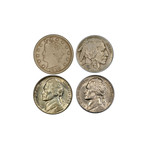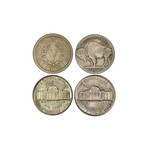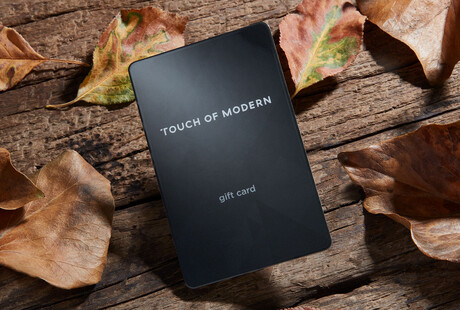Olevian Numismatic Rarities
20th Century U.S. Nickel Collection // Relics of a Bygone Era Series // Wood Presentation Box
Product Description
This 4-coin set features one of every major type and composition of U.S. 5-cent piece issued during the 20th century. Each set includes a Liberty Head nickel (1883-1913), Buffalo nickel (1913-1938), and two Jefferson nickels, including one struck in the standard copper-nickel alloy (1938-1941 and 1946-present) and one WWII emergency issue struck in a silver alloy (1942-1945). Each coin is housed in an airtight capsule and presented in a luxurious, plush-lined wood box with embossed metallic gold lettering, piano-black finish, and certificate of authenticity. The coins are unconditionally guaranteed to be genuine, dated between 1900 and 1999, and will match the quality of the ones shown.
The Liberty Head nickel was the second 5-cent coin to be struck in that metal, following the Shield nickels of 1866-1883. When introduced in January of 1883, the reverse featured a Roman numeral V to indicate the 5-cent denomination. The inclusion of the word “cents” was never considered necessary, as the three-cent piece had circulated uneventfully for years with only Roman numerals. It quickly became apparent, however, that the omission of “cents” was a serious issue, as many people began gold plating the new nickels and passing them as five-dollar gold pieces, which had a similar size. A famous tale was that of Jeff Tatum, a deaf-mute who was said to enter a store, purchase an item valued at 5 cents or less, and pay with a gold-plated nickel. If the clerk did not notice, he would erroneously be given $4.95 in change. It is said that such was the origin of the expression “just Joshing you!” Regardless, the U.S. Mint was particularly disturbed by the gold-plated nickels and ordered a design modification by June of 1883 to include the word cents. The Liberty nickel was produced in this fashion through 1913. Only 5 specimens are known to exist from this last year, making the 1913 nickel one of the most famous and coveted rarities in American numismatics. Indeed, one of these coins sold for over five million dollars in 2007! The coin set offered here is your opportunity to own a decidedly more modest but still interesting example of this important piece of American history.
As part of a drive to beautify our nation’s coinage, President Taft commissioned artist James Earle Fraser to redesign the 5-cent piece. The result was the Indian Head or “Buffalo” nickel—an American icon that became one of the most widely collected coins of the 20th century. The new nickel embodied the spirit of the Old West, with an obverse design featuring an authentic composite portrait of three Native American subjects and an American Bison on the reverse. Unlike most prior U.S. coins that possessed abundant and smooth background fields, the Buffalo nickel was boldly filled with design elements stretching to all edges and set on an irregular background in bas-relief. Production continued until the design was replaced by the Jefferson nickel in 1938. Today, the Buffalo nickel is vanishingly scarce in circulation but lives on strongly in the hearts and cabinets of coin collectors and enthusiasts.
Thomas Jefferson was a man of many talents. He is best known as the principle author of the Declaration of Independence and third president of the United States from 1801 to 1809. Jefferson’s achievements as an architect, statesman, scientist, and philosopher have earned him a lasting legacy as one of the truly great figures in American history. It is no surprise that his likeness eventually appeared on circulating U.S. coinage in 1938 and has continued to do so for over 80 years. The Jefferson nickel was designed by German-American sculptor Felix Schlag, who was awarded a $1,000 prize in April of 1938 when his model was selected among those submitted by 390 contestants. Schlag’s portrait of Jefferson was based on a marble bust by famed French sculptor Jean-Antoine Houdon. The Jefferson nickel features the left-facing president dressed in a coat of the period and wearing a peruke wig. On the reverse is a front elevation of Jefferson’s home, with the name MONTICELLO beneath it. The novelty of the Jefferson Nickel caused most examples to be saved by a curious public during its first few years, and the coin was not a familiar sight in circulation until about 1940. Shortly thereafter, the onset of World War II prompted the rationing of many commodities, including nickel, which was highly valued for use in armor plating. Congress ordered the removal of this metal from the five-cent piece, effective October 8, 1942. From that date until the end of 1945, five-cent pieces bore the regular design but were minted from an alloy of silver, copper, and manganese. These emergency coins were to be withdrawn from circulation after the war, so a prominent distinguishing feature was added. Coins from all three mints bore large mintmarks above the dome of Monticello, and the letter ‘P’ was used as a mintmark for Philadelphia for the first time. These “war nickels” proved quite satisfactory in circulation and were not immediately withdrawn. Instead, they remained a familiar sight until the mid-1960s, when rising silver prices caused them to be hoarded for their bullion value. Jefferson nickel production continues today in its original 1938 composition, albeit with several design modifications in recent years to modernize our nation’s coinage.
Product Details
- Measurements
8"L x 6"W x 2"H
- OriginUnited States
Coin 1:
— Type: Liberty Nickel (1883-1913)
— Designer: Charles E. Barber
— Weight: 5.00 grams
— Diameter: 21.2 mm
— Composition: 75% Copper, 25% Nickel
— Obverse Design: Lady Liberty, facing left, with coronet, cotton, and wheat / 13 stars
— Obverse Inscription: DATE
— Reverse Design: Wreath of cotton, wheat, and corn
— Reverse Inscription: UNITED STATES OF AMERICA / E PLURIBUS UNUM / V CENTS
Coin 2:
— Type: Buffalo Nickel (1913-1938)
— Designer: James Earle Fraser
— Weight: 5 grams
— Diameter: 21.2 mm
— Composition: 0.750 copper, 0.250 nickel
— Obverse Design: Bust of Indian Chief
— Obverse Inscription: LIBERTY / DATE
— Reverse Design: American Bison
— Reverse Inscription: UNITED STATES OF AMERICA / E PLURIBUS UNUM / FIVE CENTS
Coin 3:
— Type: Jefferson Nickel (1938-Present)
— Variety: Copper Nickel, Monticello Reverse (1938-1941, 1946-2004)
— Designer: Felix Schlag
— Weight: 5.00 grams
— Diameter: 21.2 mm
— Composition: 75% Copper, 25% Nickel
— Obverse Design: Thomas Jefferson, facing left
— Obverse Inscription: IN GOD WE TRUST / LIBERTY / DATE
— Reverse Design: Monticello
— Reverse Inscription: UNITED STATES OF AMERICA / E PLURIBUS UNUM / FIVE CENTS
Coin 4:
— Type: Jefferson Nickel (1932-Present)
— Variety: Silver (1942-1945)
— Designer: Felix Schlag
— Weight: 5.00 grams
— Diameter: 21.2 mm
— Composition: 0.560 copper, 0.350 silver, 0.090 manganese
— Net silver weight: 0.56260 troy ounces
— Obverse Design: Thomas Jefferson, facing left
— Obverse Inscription: IN GOD WE TRUST / LIBERTY / DATE
— Reverse Design: Monticello
— Reverse Inscription: UNITED STATES OF AMERICA / E PLURIBUS UNUM / FIVE CENTS
Please Note: The item(s) you receive will match the quality of the one shown, but may vary slightly due to the nature of original historical artifacts.
Shipping Information
-
Shipping AvailabilityCanada, United States
-
Shipping PolicyStandard Ground Shipping
-
Ship In3-4 weeks ⓘ
-
Return PolicyFinal sale, not eligible for return or cancellation




















































